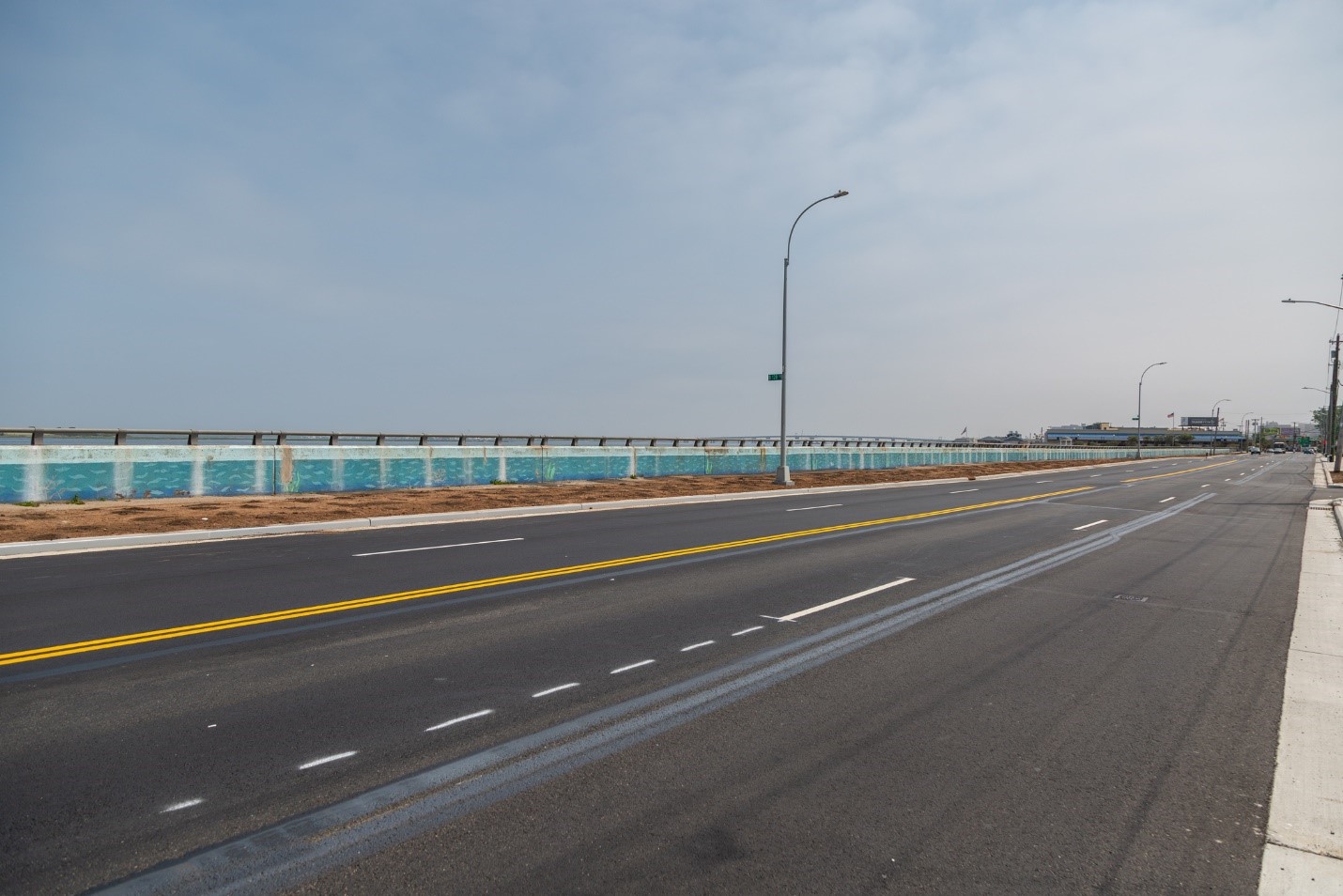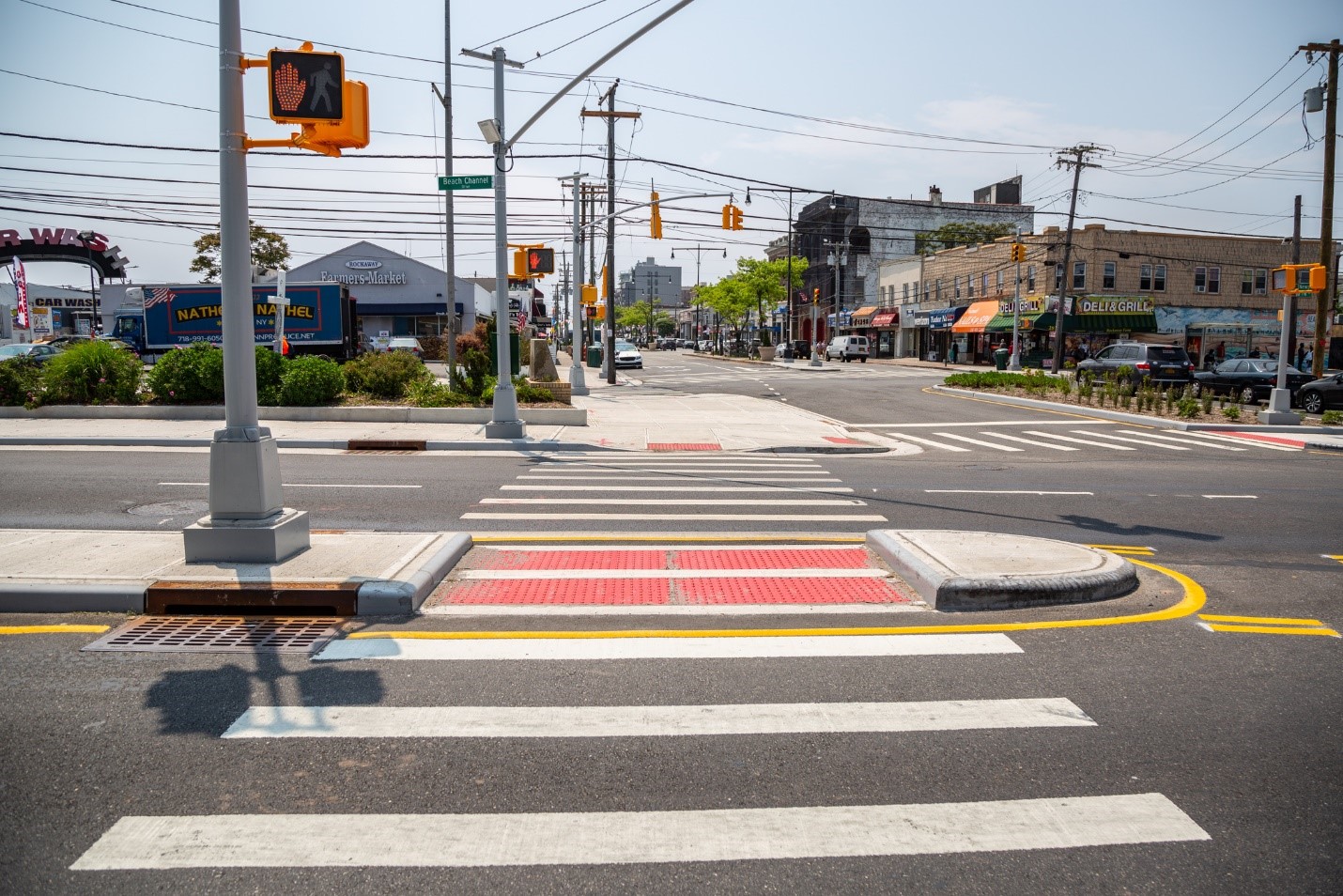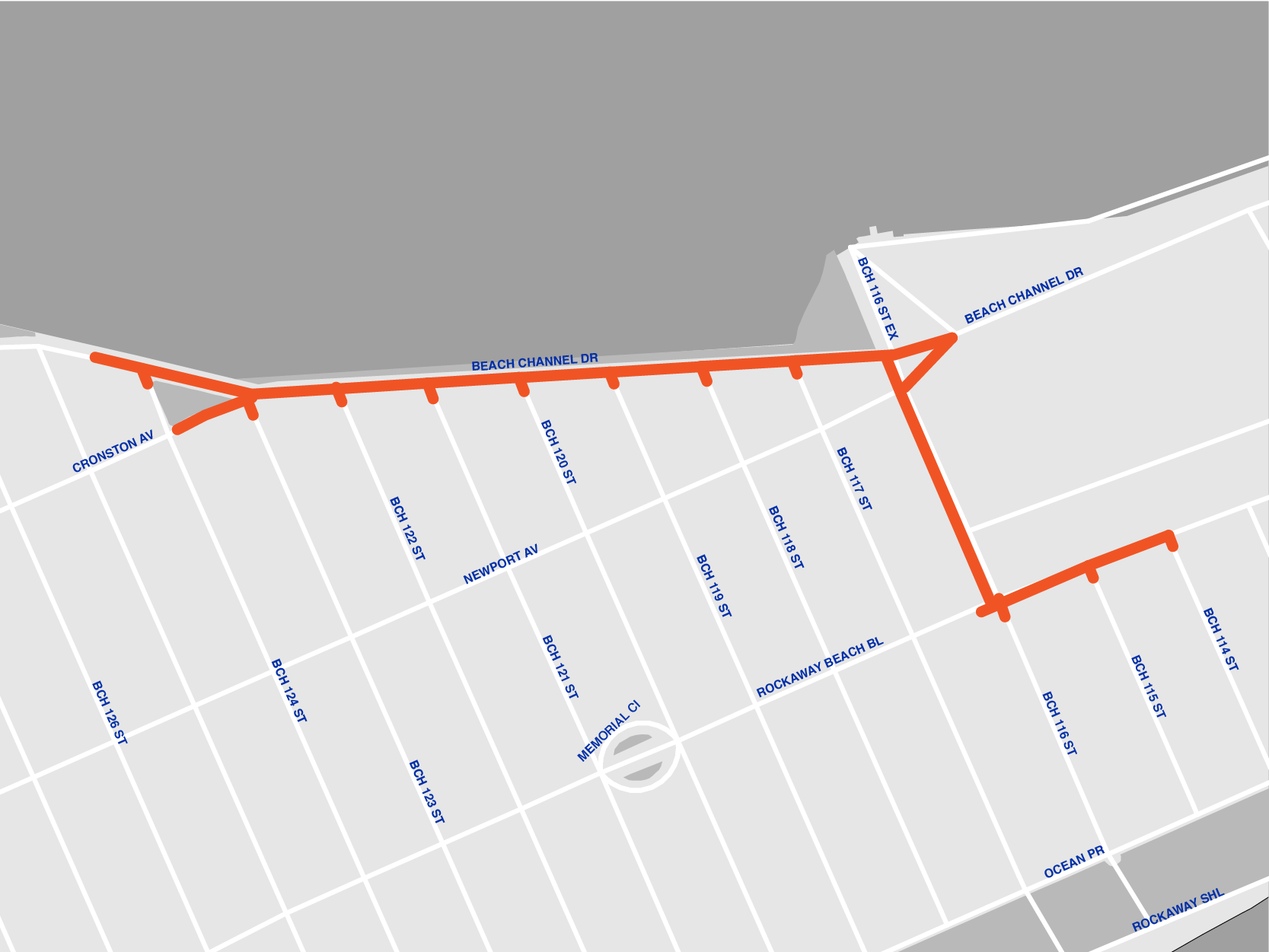
 Department of Design and Construction311
Department of Design and Construction311 Search all NYC.gov websites
Search all NYC.gov websites
City Upgrades Infrastructure and Reconstructs Streets on Beach Channel Drive in Rockaway Park
DOT: Brian Zumhagen, 212-839-4850, BZumhagen@dot.nyc.gov
DEP: 718-595-6600, DEPPressOffice@dep.nyc.gov
DDC: Shoshana Khan, 718-391-1251, KhanSho@ddc.nyc.gov
(Rockaway Park, NY – July 27, 2021) The NYC Department of Transportation (DOT), NYC Department of Environmental Protection (DEP) and NYC Department of Design and Construction (DDC) announced today that a $20 million project on Beach Channel Drive to upgrade infrastructure, alleviate flooding and improve streets that were damaged by Superstorm Sandy has been completed. DOT and DEP provided funding for the project which began in March 2018, while DDC managed the construction.

“As New York City emerges from the COVID crisis, the Rockaways are also emerging from the effects of Superstorm Sandy, and this street reconstruction and stormwater management upgrade represents a giant leap in improving the safety and quality of life for people who live and work on the peninsula, along with the many visitors who come to enjoy the area,” said DOT Commissioner Hank Gutman. “We thank our partners at DDC and DEP, our elected officials, and CB14, as well as all the residents and business owners who have worked so hard to make this project possible.”
“This $20 million investment to upgrade critical infrastructure will help to improve the quality of life on the Rockaway peninsula,” said DEP Commissioner Vincent Sapienza. “Thank you to our partners at DDC and DOT for collaborating on this important work and to the residents and businesses for their patience during construction.”
“Much of the Rockaway Peninsula was severely damaged during Superstorm Sandy and DDC has undertaken numerous infrastructure projects to help rebuild and make communities more resilient in the face of climate change,” said DDC Commissioner Jamie Torres-Springer. “This project upgraded a critical corridor facing Jamaica Bay, adding more than 2,000 feet of new storm sewers to help alleviate flooding.”

“The work just completed in Rockaway Beach is an important investment in our borough’s future that will do a great deal to enhance street conditions, alleviate flooding, increase resiliency, and improve accessibility for people with disabilities in a neighborhood that was hard hit by Superstorm Sandy,” said Queens Borough President Donovan Richards Jr. “This work underscores the City’s strong commitment to alleviating chronic flooding and addressing the significant infrastructure damage that Sandy caused. I commend the City’s Departments of Transportation, Environmental Protection, and Design and Construction for working together so effectively on this major project that will greatly improve the quality-of-life for the residents of the Rockaways.”
“This infrastructure project along Beach Channel Drive, Rockaway Beach Boulevard and Beach 116th Street will go a long way in protecting the community, residents, and businesses from flood damage and other negative effects associated with climate change and future weather conditions. The peninsula learned a lot from Sandy, especially the need to be more resilient,” said State Senator Joseph P. Addabbo, Jr. “When government agencies work together, we can accomplish anything. As we improve our Rockaway infrastructure post-Sandy, I would like to thank everyone at DOT, DEP and DDC for their work in bringing this vital project to fruition for the benefit of my constituents.”
“As more extreme weather events impact our district, the need for resilient infrastructure is crucial,” said Assembly Member Stacey Pheffer Amato. “By adding more than 2,000 feet of new storm sewers to help alleviate flooding in our community, the City is addressing our infrastructure needs, and helping us prepare for the future.”

Work occurred on 14 individual blocks along Beach Channel Drive, Rockaway Beach Boulevard and Beach 116th Street. A total of 2,115 feet of 12-inch storm sewers were added to the neighborhood and 390 feet of 10-inch sanitary sewer was replaced. To better capture stormwater and direct it to the new storm sewers, 37 new catch basins were added and 19 old ones were replaced. More than one mile (6,830 feet) of water mains were replaced with pipes ranging from 6-20 inches in diameter and fire protection was enhanced with the replacement of 22 fire hydrants.
As part of the final street restoration, 178,475 square feet of new asphalt was laid down at an angle to facilitate the flow of stormwater to the catch basins, 43,350 square feet of sidewalk was reconstructed, 6,680 feet of concrete curbs were rebuilt with steel-faced curbs and 515 feet of new curbs were installed. Throughout the project area, 120 shrubs were planted. Safety at the intersection of Beach Channel Drive and Beach 116th Street was improved with the installation of four new traffic lights.
Compliance with the American with Disabilities Act (ADA) was improved with the replacement of 32 old pedestrian ramps and the installation of four new ADA-compliant ones.
Roadway rehabilitation and reconstruction work is partially funded by the Federal Highway Administration for disaster recovery, with additional funds coming from the City for water main and sewer work, and private funds for utility relocation work.
About the NYC Department of Design and Construction
The Department of Design and Construction is the City’s primary capital construction project manager. In supporting Mayor de Blasio’s long-term vision of growth, sustainability, resiliency, equity and healthy living, DDC provides communities with new or renovated public buildings such as firehouses, libraries, police precincts, and new or upgraded roads, sewers and water mains in all five boroughs. To manage this $15.5 billion portfolio, DDC partners with other City agencies, architects and consultants, whose experience bring efficient, innovative and environmentally-conscious design and construction strategies to City projects. For more information, please visit nyc.gov/ddc.
About the NYC Department of Environmental Protection
DEP manages New York City’s water supply, providing approximately 1 billion gallons of high-quality drinking water each day to more than 9 million residents, including 8.3 million in New York City. The water is delivered from a watershed that extends more than 125 miles from the city, comprising 19 reservoirs and three controlled lakes. Approximately 7,000 miles of water mains, tunnels and aqueducts bring water to homes and businesses throughout the five boroughs, and 7,500 miles of sewer lines and 96 pump stations take wastewater to 14 in-city treatment plants. DEP has a robust capital program, with a planned $20.1 billion in investments over the next 10 years that will create up to 3,000 construction-related jobs per year. For more information, visit nyc.gov/dep, like us on Facebook, or follow us on Twitter.
About the NYC Department of Transportation
NYC DOT's mission is to provide for the safe, efficient, and environmentally responsible movement of people and goods, and to maintain and enhance the transportation infrastructure crucial to the economic vitality and quality of life of New York City residents. More than 5,000 DOT employees oversee one of the most complex urban transportation networks in the world, managing 6,000 miles of streets and highways, 12,000 miles of sidewalk, and 794 bridges and tunnels, including the iconic East River bridges. Our staff also installs and maintains more than one million street signs, 12,000 signalized intersections, 315,000 street lights, and 200 million linear feet of street markings. DOT promotes the use of sustainable modes of transportation, designing bicycle facilities, bus lanes, and public plazas. DOT also operates the Staten Island Ferry, which serves over 22 million people annually.


